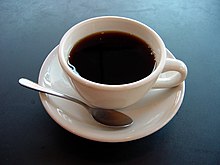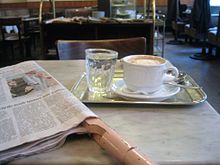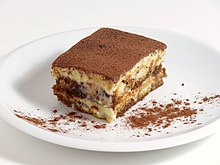Coffee is one of the world's most popular drinks, with significant cultural variations. It is also the most consumed psychotropic substance (by number of regular or intermittent consumers) in the world and present almost everywhere. Like tea, there are several local variations on this beverage served worldwide.
Understand
[edit]| “ | Coffee has helped create exactly the kind of world that coffee needs to thrive: a world driven by consumer capitalism, ringed by global trade, and dominated by a species that can now barely get out of bed without its help. | ” |
—Michael Pollan | ||
Types of coffee
[edit]
There are well over 100 known species in the genus coffea, but only a few are commercially important. Coffee beans are mostly of two main types:
- Robusta coffee being the most widely produced.
- Arabica coffee being considered the higher quality one.
A third, less common, variety is Liberica which grows on a tree rather than a bush. Of the three, Liberica has the lowest caffeine concentration and Robusta the highest. A fourth variant is Excelsa, which some consider only a variant of Liberica rather than a separate species.
Coffee can be purchased as instant granules, which are used by most hotel rooms, though many cafés purchase roasted coffee beans and then grind them themselves to make coffee, usually starting with a single shot of espresso. For drinkers who desire more caffeine or a stronger flavour, additional shots can be requested. Coffee can also be bought as roasted and ground, which is the common form in some countries. Coffee can be brewed or boiled instead of using the espresso technique.
Coffee can be served black (as in no milk added), white (with cream, or milk in straight, 'frothed' or condensed forms) or even sometimes with alcohol (as in a shot of whisky to make 'Irish Coffee'). Many people prefer to add sugar to their coffee to counter the inherent bitter taste.
Common coffee types served around the world include:
- Americano: a shot of espresso with hot water to the brim
- Cappuccino: a shot of espresso with a milk foam, sometimes with spices
- Cortado: a shot of espresso with a shot of milk
- Espresso: a single shot of coffee in a thicker, concentrated form
- Flat white: a small coffee from Oceania where the espresso mixed with very hot milk
- Latte: short for the Italian caffè latte, coffee with milk, although latte may also refer to cappuccino. French café au lait and Spanish café con leche refer to similar servings, in big cups with equal parts milk and coffee. There are several variants going by different names, with the coffee base and the type and amount of milk varying.
- Mocha: named after the historic coffee trade city of Mocha, Yemen. A coffee with chocolate and milk
Coffee liqueurs such as Tia Maria and Kahlúa can be used to make alcoholic cocktails such as:
- Black Russian: made with vodka and coffee liqueur
- Irish Coffee: made with hot coffee, Irish whiskey, and sugar, stirred, and topped with cream. The coffee is drunk through the cream.
- Coffee martini: made with vodka, espresso coffee, coffee liqueur, and sugar syrup. It is not a true martini as it contains neither gin nor vermouth, but is one of many drinks that incorporate the term into their names.
Regional coffee cultures
[edit]Coffee is one of the world's most traded commodities, and you can probably find many types in your home region. Nevertheless, there are many distinctive ways of drinking coffee around the world that are worth experiencing.

Africa
[edit]- Ethiopia is the botanical home of the coffee plant and some places still offer coffee brewed the traditional way
Americas
[edit]
- New Orleans has its own unique style of coffee known as café au lait. In contrast to its French namesake, it is flavoured with roasted chicory and uses scalded milk.
- Colombia is widely known for its coffee traditions, which are listed by UNESCO as a part of the world's cultural heritage. Most Colombian coffee is grown in a region of the Andes known as the Zona Cafetera, sometimes called the Eje Cafetera. Many plantations offer tours and roasters and coffee shops are common throughout the country. Even in the most remote part of Colombia, there is likely to be a Juan Valdez coffee shop.
- While Nicaragua grows a lot of coffee (in its Northern Highlands), the tradition of drinking coffee is surprisingly weak outside of growing regions and major cities.
- Costa Rica used to be dominated politically by the coffee growing class and the beverage is still a favorite of all classes and ethnic groups as well as one of the main agricultural exports. Some Costa Rican coffees are roasted and blended with a small amount of cane sugar, giving them a uniquely sweet signature.
- Mexico is a leading exporter of organic coffee. Coffee is grown in the states of Oaxaca, Veracruz, and Chiapas. Gourmet coffee bars, roasters and skilled baristas are becoming more common, but sadly, it's still common to have even first-class hotels and restaurants think it's okay to serve Nescafe instead of brewed coffee, let alone quality coffee (ask before you order, especially after dinner, when coffee is rarely requested by Mexicans). Cafe de Olla is coffee brewed with cinnamon.
Asia and Oceania
[edit]- See also: Western_food_in_Asia#Coffee
- Visit a kissaten in Tokyo
- Have a frog coffee in Vietnam, or otherwise Vietnamese-style filtered coffee is unique too
- It is hard to beat a good 'flat white' in Melbourne, Australia
- Ipoh "white" coffee from Malaysia, roasted with palm oil and served with condensed milk
- Try a Kopi Luwak in Indonesia. Expensive and unusual in that it was prepared by passing through the digestive tract of a civet cat. This can now also be found in most other Southeast Asian nations.
- In Java in Indonesia, the strong black coffees with a base of sugar similar to Turkish, but Javanese in style
- The Philippine provinces of Batangas and Cavite have their own variety of coffee called kapeng barako. This is neither arabica nor robusta, but liberica that grows on a tree rather than a bush.
- South Australia has Farmer's Union Iced Coffee, a local band of strong, flavourful iced coffee. One of the few places in the world where coffee and not soda is the most consumed beverage.
- Hainan is known in China for its coffee culture because of the influence of returning overseas Hainanese from Southeast Asia.
- The Arabs of the Middle East and North Africa have their own distinctive style of drinking coffee, in which cardamom is added to the coffee.
- A Korean 'Iced Americano' or 'Ah-Ah' on a freezing winter morning or steamy summer day
Europe
[edit]
- Viennese cafes in Austria, have a coffee with the famous Viennese Sachertorte chocolate cake made with apricot jam
- A strong Turkish coffee in Istanbul, or a very similar Greek (alternative choice is the Frappé, which is instant cold coffee), Armenian or Bosnian coffee
- Try a delicious tiramisù dessert that is traditionally made with espresso-soaked ladyfingers (savoiardi), mascarpone cheese, marsala wine and cocoa powder. Or take a shot of espresso straight from the machine in Milan, Italy
- Indulge in the Swedish fika culture.
Buy
[edit]Selling coffee in bulk has one of the highest profit margins of any consumable, so there is no shortage of places to grab a cup of coffee!
- Specialist independent coffee shops are considered to provide the best-tasting coffee, sometimes roasting beans onsite, grinding the beans before making and taking good care of their machines. Unfortunately, it is hard to determine which ones are good. Best to seek online reviews or just ask people living locally!
- High street chains, of which Starbucks is the best known, can provide consistent although not great coffee in most countries around the world. Other examples include Costa Coffee and Caffè Nero.
- Fast food restaurants such as McDonalds can also provide a quick coffee fix at a cheaper price than the high street chains. The taste is also not very different.
- Convenience stores have coffee machines which dispense coffee though the quality can be variable.
Coffee plantations
[edit]
Coffee grows best under certain conditions, typically in warm climates at high altitudes. The mountains of Jamaica, Colombia, Brazil, Papua New Guinea, Ethiopia and Kenya are ideal. Some countries such as Costa Rica or Nicaragua used to depend or still depend on a good coffee harvest and you may be able to visit farms there as a form of ecological and or volunteer tourism
- Skybury Tropical Coffee Plantation, Skybury Farmgate, 136 Ivicevic Road, Paddy's Green, Mareeba, Queensland, Australia. Tour the coffee bushes in the far Australian north, and sample some freshly produced drinks as well. Australia is actually a tiny producer of coffee worldwide, and most of it comes from this farm.
Coffee visitor attractions
[edit]Asia
[edit]Europe
[edit]- 3 Museo Lavazza (Lavazza Museum), Turin, Italy. All about coffee and the Lavazza brand, in a former coffee factory.
- 4 Vilkkimäen kahvimuseo (Vilkkimäki Coffee Museum), Lieto, Finland. Within the walls of an old dairy, there is a coffee museum, on the shelves of which you can find an extensive coffee-related collection. It includes plenty of coffee packages, as well as various coffee pots, coffee grinders, toasters and other coffee-related items.
South America
[edit]- 5 National Coffee Park (Parque Nacional del Café), Montenegro, Colombia. A coffee theme park in the Andean mountains.
Learn
[edit]Being a Barista can either be a good way to get a short term job whilst traveling, or a way to develop a long term career.
Stay healthy
[edit]
Coffee contains caffeine which is a stimulant and excessive amounts are not healthy. People with high blood pressure or who suffer from insomnia should take care not to consume too much. Coffee can be addictive.
In some countries, coffee is widely available in decaffeinated form.
'Old coffee' is not dangerous to drink, but tastes pretty bad. The taste of coffee comes from the oils, and they become rancid over time. Ideally, the coffee should be brewed straight after the beans are ground, and ground coffee should be consumed within a few weeks at the very most.
Decaffeinated coffee or the variety of replacement substances that may or may not taste like coffee may be better for your health, especially if you have problems with the heart or blood pressure.
Stay safe
[edit]While coffee does contain a psychotropic substance (caffeine) and prolonged exposure does produce (mild) withdrawal symptoms (sleepiness, headaches and other symptoms), its health risks occur when taken in heavy amounts, where caffeine toxicity is of concern and a medical issue, but the average coffee drinker would never reach that level. The caffeine content in energy drinks may be much higher and excessive consumption of them may be more of a risk.
Even the benefits are low and nothing to worry about for healthy adults. That being said, the bitter taste makes it (theoretically) easier to "spike" than plain water, as many substances that could knock you out have a bitter taste. It is however still very rare and the worst that could happen to you drinking a coffee in most places are bag-snatching, pickpocketing or the (perfectly legal) high prices in some places.
Respect
[edit]Coffee is rarely regarded as a vice around the world, although Mormons, Seventh Day Adventists and some Baptists in the United States, as well as the Hare Krishnas, refrain from consuming it due to religious reasons.
Coffee shops often provide a lounge type area where you can sit, read and relax. Although convenient for the traveler, try not to hog your table and seat for hours and hours since other people may also want to sit and the business needs more customers for their livelihood. If you must stay for a long time, then at least purchase more drinks or food now and then.
Some countries, such as the United States, are very accommodating for customizing your coffee with a variety of syrups and milk variants. Baristas in other 'more traditional' countries may find too many requests for a special coffee very annoying. If you really need a 'Grande, Iced, Sugar-Free, Vanilla Latte With Soy Milk' or 'Iced, Half Caff, Ristretto, Venti, 4-Pump, Sugar Free, Cinnamon, Dolce Soy Skinny Latte' then consider visiting a local chain coffee shop, used to such tastes.

